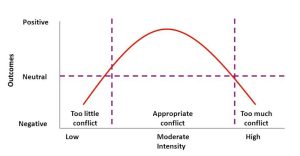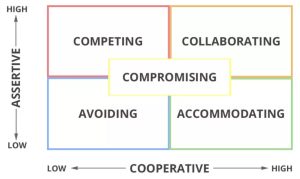6.2 Navigating Group Conflict
Learning Objectives
- Define conflict
- Differentiate between functional and dysfunctional conflict
- Recognize various types of conflict in groups
- Describe the conflict process
- Identify and apply strategies for preventing or reducing conflict in groups
Definitions of Conflict
Hocker and Wilmot (2001) defined conflict as an expressed struggle between interdependent parties over goals which they perceive as incompatible or resources which they perceive to be insufficient. Let’s examine the ingredients in their definition.
First of all, conflict must be expressed. If two members of a group dislike each other or disagree with each other’s viewpoints but never show those sentiments, there’s no conflict.
Second, conflict takes place between or among parties who are interdependent—that is, who need each other to accomplish something. If they can get what they want without each other, they may differ in how they do so, but they won’t come into conflict.
Finally, conflict involves clashes over what people want or over the means for them to achieve it. Party A wants X, whereas party B wants Y. If they either can’t both have what they want at all, or they can’t each have what they want to the degree that they would prefer to, conflict will arise.
The Positive and Negative Sides of Conflict
There are some circumstances in which a moderate amount of conflict can be helpful. For example, conflict can stimulate innovation and change. Conflict can help individuals and group members grow and develop self-identities. As noted by Coser (1956):
Conflict, which aims at a resolution of tension between antagonists, is likely to have stabilizing and integrative functions for the relationship. By permitting immediate and direct expression of rival claims, such social systems are able to readjust their structures by eliminating their sources of dissatisfaction. The multiple conflicts which they experience may serve to eliminate the causes for dissociation and to re-establish unity. These systems avail themselves, through the toleration and institutionalization of conflict, of an important stabilizing mechanism.
Conflict can have negative consequences when people divert energies away from performance and goal attainment and direct them toward resolving the conflict.

Continued conflict can take a heavy toll in terms of psychological well-being. Conflict has a major influence on stress and the psychophysical consequences of stress. Finally, continued conflict can also affect the social climate of the group and inhibit group cohesiveness.
Thus, conflict can be either functional or dysfunctional depending upon the nature of the conflict, its intensity, and its duration. Indeed, both too much and too little conflict can lead to a variety of negative outcomes, as discussed above. This is shown in Figure 6.2.1. In such circumstances, a moderate amount of conflict may be the best course of action. The issue for groups, therefore, is not how to eliminate conflict but rather how to manage and resolve it when it occurs.
Figure 6.2.1 Conflict Intensity and Outcomes

Types of Conflict
Group conflicts may deal with many topics, needs, and elements. Kelly (2006) identified the following five types of conflict:
First, there are conflicts of substance. These conflicts, which relate to questions about what choices to make in a given situation, rest on differing views of the facts. If Terry thinks the biology assignment requires an annotated bibliography but Robin believes a simple list of readings will suffice, they’re in a conflict of substance. Another term for this kind of conflict is “intrinsic conflict.”
Conflicts of value are those in which various parties either hold totally different values or rank the same values in a significantly different order. The famous sociologist Milton Rokeach (1979), for instance, found that freedom and equality constitute values in the four major political systems of the past 100 years—communism, fascism, socialism, and capitalism. What differentiated the systems, however, was the degree to which proponents of each system ranked those two key values. According to Rokeach’s analysis, socialism holds both values highly; fascism holds them in low regard; communism values equality over freedom, and capitalism values freedom over equality. As we all know, conflict among proponents of these four political systems preoccupied people and governments for the better part of the twentieth century.
Conflicts of process arise when people differ over how to reach goals or pursue values which they share. How closely should they stick to rules and timelines, for instance, and when should they let their hair down and simply brainstorm new ideas? What about when multiple topics and challenges are intertwined; how and when should the group deal with each one? Another term for these disputes is “task conflicts.”
Conflicts of misperceived differences come up when people interpret each other’s actions or emotions erroneously. You can probably think of several times in your life when you first thought you disagreed with other people but later found out that you’d just misunderstood something they said and that you actually shared a perspective with them. Or perhaps you attributed a different motive to them than what really underlay their actions. One misconception about conflict, however, is that it always arises from misunderstandings. This isn’t the case, however. Robert Doolittle (1976) noted that “some of the most serious conflicts occur among individuals and groups who understand each other very well but who strongly disagree.”
The first four kinds of conflict may interact with each other over time, either reinforcing or weakening each other’s impact. They may also ebb and flow according to the topics and conditions a group confronts. Even if they’re dealt with well, however, further emotional and personal kinds of conflict can occur in a group. Relationship conflicts, also known as personality clashes, often involve people’s egos and sense of self-worth. Relationship conflicts tend to be particularly difficult to cope with since they frequently aren’t admitted for what they are. Many times, they arise in a struggle for superiority or status.
A Model of the Conflict Process
The most commonly accepted model of the conflict process was developed by Kenneth Thomas (1976). This model consists of four stages: (1) frustration, (2) conceptualization, (3) behavior, and (4) outcome.
an expressed struggle between interdependent parties over goals which they perceive as incompatible or resources which they perceive to be insufficient
conflicts that relate to questions about what choices to make in a given situation; rest on differing view of the facts
conflicts in which various parties either hold totally different values or rank the same values in a significantly different order
conflicts that arise when people differ over how to reach goals or pursue values which they share
conflicts that occur when people erroneously interpret each other’s actions or emotions
conflicts that involve people’s egos and sense of self-worth; often referred to as personality clashes
the imaginary bag we all carry into which we place unresolved conflicts of grievances over time; leads to frustration and influences how we interpret actions


